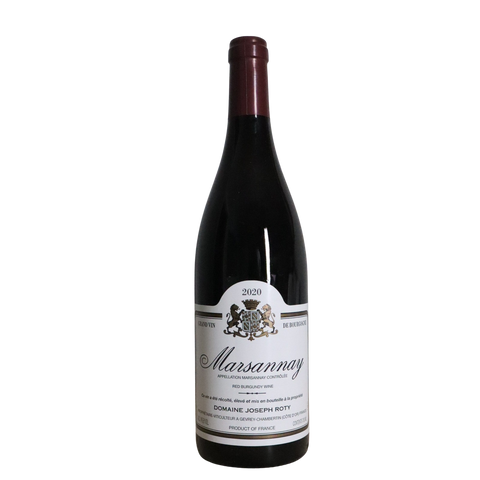
2020 Domaine Joseph Roty Marsannay Rouge, Burgundy, France
The nose offers up an enticing mix of red and black fruit, rose petal and violet aromas. The palate is fleshy on the entry with fine grip and quite saline leading to a lovely savory finish. This is classic Marsannay that is ever so elegant!
There are 3 units left in stock.
ABOUT THIS WINE
Vinified in steel tank prior to racking into 40% New Oak and 60% Neutral Oak (all French oak) barrels. Aged in barrel for 18 months then bottled and kept in cellar for another 10 months before commercializing.
The Marsannay Rouge ‘Boivin’ from Domaine Joseph Roty is a single vineyard bottling from the upper slope in the village of Marsannay-la-Côte. The vineyard site ‘Boivin’ was previously part of the forest that can be seen from the vineyard. The name ‘Boivin’ refers to the evolution of the site from forest ‘Bois’ meaning wood) to vineyard (‘Vin’ meaning wine). Wine produced from Boivin is typically firmer with darker red and black fruit than most other Marsannay that are produced from vines downslope or on the plateau.
ABOUT THIS PRODUCER
Domaine Joseph Roty boasts one of the largest concentrations of old vines in Burgundy, averaging about 65 years. The domaine is fanatical about old vines, they have some of the oldest in France, the living ambassadors of the affinity the Roty’s so obviously feel for their land. Coupled with late picking, which further concentrates yields and with fermentation below 30 degrees, and a cuvaison of three weeks, the structure and complexity is consequentially remarkable and the winemaking uncompromising in achieving this. With a little age these wines develop wonderful aromatics with the characteristic Pinot Noir flavours of black cherry and stone fruit. The old vine fruit contributes the length of flavour and great complexity. Roty’s Charmes Chambertin Cuvée Trѐs Vieilles Vignes is largely harvested from vines of over 120 years.
One of the great domaines of Gevrey. Pierre-Jean has taken up the reins and seems to intent on following the families somewhat idiosyncratic, uncompromising path. “Nothing changes” as Madame Roty told us on our last visit. These are not fashion-conscious wines, everything is destemmed, new oak is relatively high, around 50% on the village wines, 60-70% on the Lieux-Dit and 100% on the Grand Cru. They are wines made to age, there is little point opening them young.
Roty developed his own custom heat exchanger to cool the tanks and delay the onset of fermentation for a week or more, which enabled him to minimize sulfur additions to the vats. His use of wooden cuvées for fermentation (the tops are closed once the tanks are filled), which take a while to heat up, also helped him draw out the pre-fermentation cold soak. (Extended cold maceration clearly brings deeper color, which some other producers try to achieve through very warm fermentation temperatures.) Roty began working with wild yeasts in 1985, and the wines here have been fermented entirely with indigenous yeasts since the harvest of 1987.
Philippe and now Pierre-Jean adopted their father’s practices with very few significant adjustments; in my tastings with them over the past nearly 20 years, both made it clear to me that they were not interested in making any substantial changes to their father’s methods. Pierre-Jean continues to add very little sulfur during the juice stage, although he now uses a more modern and effective heat exchanger to cool the grapes and delay the onset of the fermentation. He continues to take advantage of batonnage, depending on the needs of each vintage. But after several years of experimenting with stainless steel tanks with his brother Philippe, Pierre-Jean no longer vinifies in wooden vats. The Rotys modernized their vat room in 2014 and now use only stainless steel and a few concrete tanks. (But note that all of the vintages in my recent tasting were vinified in wooden vats.)
Details:
| Grape(s) | Pinot Noir |
| Farming | Organic |
